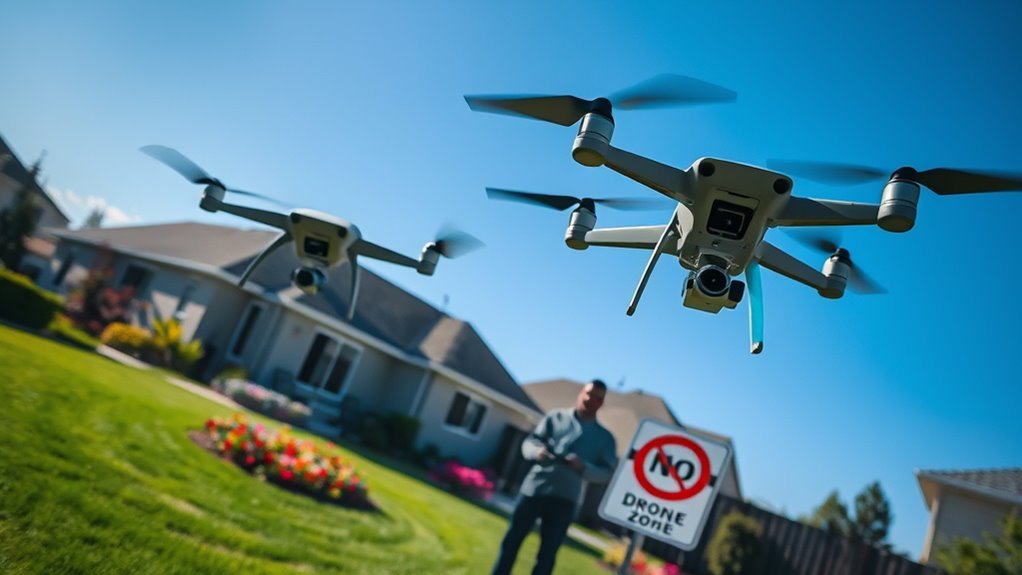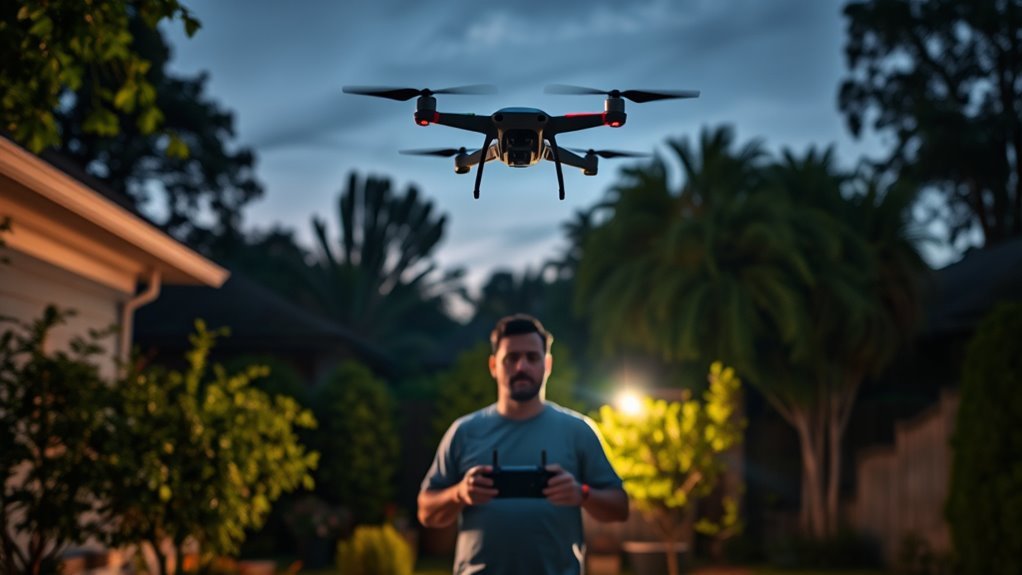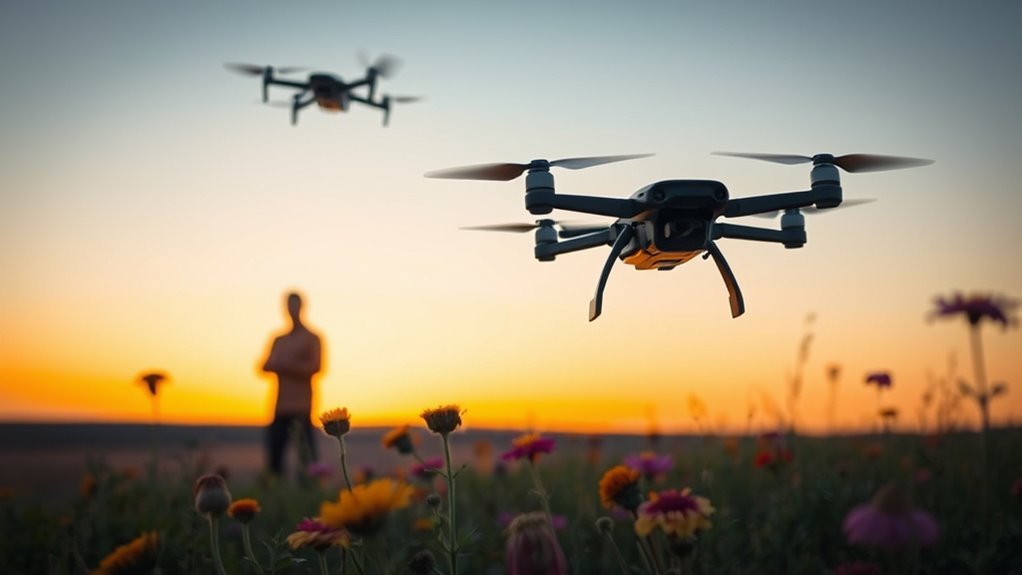Legally shooting down unwanted drones is fraught with complexities. You need to understand that federal regulations, governed by the FAA, prohibit damaging drones in most cases. As a property owner, you have rights regarding the airspace above your land, but actions like shooting down drones can lead to legal consequences, including destruction of property charges. Consider non-lethal alternatives, such as reporting to authorities or using jamming techniques. Learn more about effective strategies for dealing with intrusive drones.
Understanding Drone Laws and Regulations

While it might be tempting to take matters into your own hands when encountering a drone, understanding the laws and regulations surrounding drone use is essential. Many people are unaware that drone privacy laws vary by state, and shooting down a drone could lead to severe legal consequences. The FAA, for instance, regulates airspace and prohibits individuals from damaging drones, even if they intrude on your privacy. Legal exemptions exist, but they’re often narrowly defined. Familiarizing yourself with these regulations can empower you to protect your space without resorting to unlawful actions. Always consider reporting intrusive drone activity to authorities instead, as this approach respects both your rights and the legal framework designed to balance personal freedoms with responsible drone operation. Additionally, understanding the legal implications of drone interference can help you navigate these situations more effectively. Drones’ signal attenuation through walls and barriers further complicates privacy concerns, making it essential to be informed about both technological limitations and legal rights.
Your Rights as a Property Owner

As a property owner, it’s essential to understand your rights regarding airspace and boundaries. You’re entitled to control what happens above your property, but this is subject to specific regulations and state laws. Knowing these details will help you navigate the complexities of drone interactions effectively.
Understanding Airspace Regulations
Understanding airspace regulations is essential for property owners who may feel threatened by drones invading their privacy. The airspace above your property isn’t just a void; it’s classified into different airspace classifications that dictate who can fly where. Generally, drones operate in specific drone flight zones, which can overlap with private property. Knowing these classifications helps you determine your rights and limitations regarding aerial intrusions. For instance, recreational drone pilots must adhere to FAA guidelines, and these often restrict altitude and proximity to buildings. By staying informed about these regulations, you can assert your rights effectively while respecting the legal landscape surrounding drone use. Empowering yourself with this knowledge is crucial for maintaining your privacy and freedom.
Property Boundary Rights
Airspace regulations provide a framework for understanding your rights as a property owner when it comes to drone activity above your land. You typically own the airspace above your property lines, but disputes can arise if a drone intrudes on that space. Here’s a quick look at your rights:
| Aspect | Details |
|---|---|
| Property Lines | Define your ownership rights |
| Drone Height Limits | Varies per regulations and local laws |
| Boundary Disputes | Can lead to legal action if unresolved |
Understanding these factors can empower you to take appropriate action against unwanted drone surveillance or intrusion. Stay informed, and know when to assert your rights.
State-Specific Laws
Each state has its own set of laws governing drone usage, which can greatly impact your rights as a property owner. Understanding these state laws is essential, as they vary considerably across regions. Some states allow you to take action against drones invading your airspace, while others might impose restrictions on how you can respond. For instance, in certain areas, you may find that shooting down a drone is considered destruction of property, regardless of where it’s operating from. Familiarizing yourself with these regional differences can empower you to defend your property rights effectively. Always consult local regulations or legal counsel to guarantee your response to unwanted drones aligns with your state’s laws and protects your freedoms.
Non-Lethal Alternatives to Shooting Down Drones

When it comes to managing unwanted drones, non-lethal options like signal jamming and drone net capture can be effective alternatives. These methods allow you to disrupt the drone’s operation without causing permanent damage. Understanding how to implement these techniques legally can help protect your privacy and property rights.
Signal Jamming Techniques
Many individuals and organizations are exploring signal jamming techniques as a legal and non-lethal alternative to taking down drones. This approach relies on creating signal interference, disrupting the communication between the drone and its operator, effectively causing it to lose control without physical harm. By utilizing specific frequencies, you can enhance drone detection and identify unwanted intrusions into your airspace. While jamming is a powerful tool, it’s crucial to stay informed about your local laws, as unauthorized use can lead to serious legal consequences. Understanding the technology behind signal jamming empowers you to protect your privacy and maintain your freedom while remaining within the legal boundaries. Always prioritize non-lethal methods to guarantee safety for both yourself and the drone operator.
Drone Net Capture
While signal jamming can effectively disrupt drone operations, another non-lethal method gaining popularity is drone net capture. This technique involves deploying a specialized net designed to ensnare and immobilize unwanted drones, allowing for controlled removal without destruction. Using drone capture systems, you can target rogue UAVs while minimizing the risk of collateral damage to surrounding areas or individuals. The net deployment occurs from either ground-based devices or aerial drones, providing flexibility in various environments. This approach not only preserves public safety but also respects personal freedoms by allowing individuals to manage intrusive surveillance or potential threats. As drone technology advances, embracing non-lethal methods like net capture becomes increasingly essential for protecting your rights and privacy.
Reporting Unwanted Drones to Authorities
Have you ever spotted a drone hovering too close for comfort? If so, it’s essential to know the proper reporting procedures. Start by documenting the drone’s appearance, behavior, and location. This information will be important when you contact local authorities. In many areas, law enforcement agencies handle drone complaints, as they can assess any potential violations of privacy or airspace regulations. When reporting, be concise and provide as much detail as possible. This allows authorities to act swiftly and effectively. Remember, while you may feel an urge to confront the drone operator directly, it’s often safer and more effective to let local authorities handle the situation. Your vigilance can help maintain both your privacy and community safety.
Legal Consequences of Shooting Down Drones
Shooting down a drone, even if it’s invading your privacy or causing disturbance, can lead to severe legal repercussions. You may face liability issues if the drone belongs to someone else, as damaging property can result in costly civil claims. Additionally, local and federal laws classify shooting down drones as a criminal act, which could lead to criminal charges, including fines or imprisonment. Even if you believe your actions are justified, the legal system might not agree. It’s vital to understand that while you might feel a strong urge to protect your space, the legal ramifications could outweigh your immediate concerns. Always consider the peaceful alternatives before taking drastic measures that could jeopardize your freedom. Consulting authoritative sources for clarification on permissible responses is essential to avoid potential legal issues.
Protecting Your Privacy Without Resorting to Violence
Understanding the legal risks associated with shooting down drones highlights the importance of exploring non-violent methods to protect your privacy. Privacy concerns are increasingly relevant in an era dominated by drone surveillance. Instead of resorting to drastic measures, consider implementing barriers like privacy screens or dense vegetation to obstruct views from above. You can also invest in anti-drone technology, such as signal-jamming devices, which can disrupt unwanted surveillance without causing harm. Engaging local authorities about your privacy concerns can lead to regulations that limit drone operations in residential areas. Additionally, employing advanced AI integration can help enhance your strategies for monitoring and managing drone activity effectively. Educating your community about the implications of drone usage fosters a collective awareness that may prompt local action or advocacy for more stringent privacy laws. Your freedom to enjoy personal space can be defended through peaceful, informed strategies. Additionally, understanding local regulations governing drone flights can empower you to advocate for your rights effectively.
Frequently Asked Questions
Can I Use a Drone to Chase Away Other Drones?
Imagine a vigilant knight, wielding a drone as a shield. You can use aerial surveillance techniques and drone defense strategies to deter unwanted drones, but remember, it’s essential to stay within legal boundaries while doing so.
What Should I Do if a Drone Flies Over My Property?
If a drone flies over your property, consider your drone privacy rights. Document the incident, but be cautious of legal consequences; engaging aggressively could lead to trouble. Consult local laws to understand your options effectively.
Do I Need to Inform Neighbors About Shooting Down Drones?
You should definitely consider informing neighbors before taking action against drones. Drone regulations often require neighbor consent, and maintaining good relationships while ensuring your rights can prevent conflicts and misunderstandings in your community.
Are There Specific Drone Types I Cannot Legally Target?
Certain drone types, like those operated by law enforcement or commercial entities, often fall under legal restrictions that prevent you from targeting them. Always check local laws to avoid potential legal consequences before taking any action.
Can I Set up Traps for Unwanted Drones on My Property?
Imagine your property as a fortress, defending against unwelcome invaders. While drone traps might seem appealing, your property rights don’t guarantee legality. Consult local laws to navigate this complex landscape before setting any traps.

